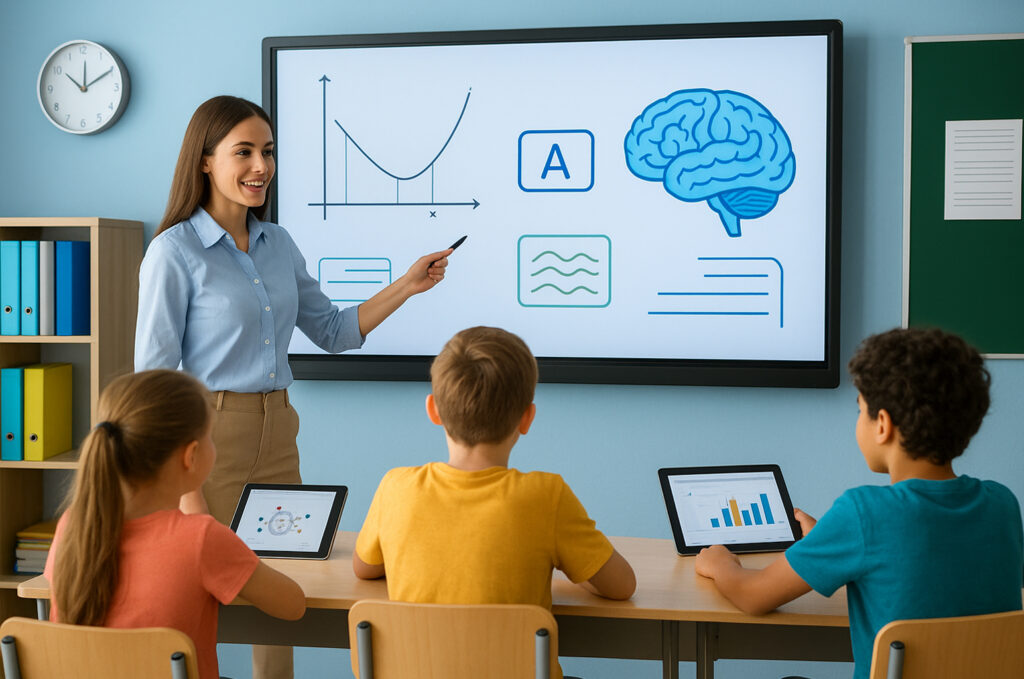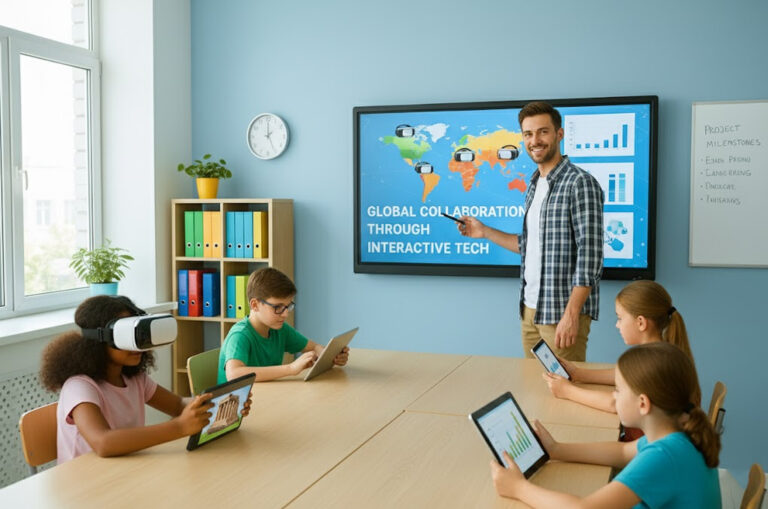Premium Biz Post – In today’s fast-evolving academic landscape, Interactive Technology Strengthens Digital, helping schools, universities, and training institutions embrace modern solutions that simplify IT and improve student engagement. As classrooms become increasingly digital, technology is no longer a supplementary tool—it is the foundation of how knowledge is shared, measured, and experienced.

The Shift Toward Digital Education
Over the past decade, education systems worldwide have been undergoing a massive transformation. The integration of technology into classrooms has become essential rather than optional. From virtual classrooms and smartboards to AI-driven learning analytics, interactive tools are redefining the traditional teacher-student dynamic.
The COVID-19 pandemic accelerated this digital shift, forcing institutions to rely heavily on online and hybrid learning platforms. However, what began as a temporary necessity has now evolved into a sustainable model of digital learning. Schools and universities continue to adopt advanced educational technologies that support collaboration, accessibility, and personalized learning experiences.
Interactive technology, such as touchscreen displays, smartboards, VR tools, and cloud-based platforms, empowers educators to create more engaging lessons while enabling students to learn through experience rather than passive observation.
Simplifying IT and Enhancing Accessibility
One of the primary challenges in education today is managing complex IT infrastructure while ensuring accessibility for all learners. Interactive technology helps address this issue by simplifying processes and reducing the need for specialized hardware or software maintenance.
Cloud-based learning management systems (LMS) like Google Classroom, Microsoft Teams for Education, and Moodle offer scalable solutions for schools of all sizes. These systems allow teachers to share resources, track progress, and communicate with students in real-time—all from a single dashboard.
Interactive whiteboards and digital projectors have replaced traditional chalkboards, making lessons more dynamic and visual. Teachers can easily incorporate multimedia content, quizzes, and live polls into lessons, making the learning process more inclusive and enjoyable. Moreover, accessibility features such as real-time captions, screen readers, and adaptive input devices ensure that students with disabilities can fully participate in digital classrooms.
The Role of Data and AI in Personalized Learning
Artificial intelligence (AI) has become a cornerstone of modern education technology. AI tools analyze student data to identify learning patterns, strengths, and weaknesses, enabling teachers to tailor instruction to individual needs. For example, AI-based platforms can recommend exercises, adjust difficulty levels, and provide instant feedback, helping students progress at their own pace.
In digital learning environments, data analytics helps administrators monitor performance metrics across classes and institutions. This data-driven approach promotes accountability and enables schools to make informed decisions about curriculum design, resource allocation, and teaching strategies.
Interactive technology also supports formative assessment, where teachers continuously evaluate student understanding through real-time quizzes or feedback tools. Instead of waiting for exams, educators can intervene earlier to provide support or modify lesson plans as needed.
Read More : ”Suitcase Side Table A Vintage Touch Full of Creativity”
Bridging the Gap Between Teachers and Students
Traditional classrooms often face the challenge of maintaining student attention and engagement. Interactive learning technologies bridge this gap by making lessons participatory and immersive. For example, touchscreen devices and collaborative apps allow students to contribute directly to group projects or classroom discussions, even in virtual settings.
In STEM subjects (Science, Technology, Engineering, Mathematics), augmented reality (AR) and virtual reality (VR) technologies bring complex concepts to life. Students can explore 3D models of the human body, simulate chemical reactions, or visualize mathematical equations—all through interactive interfaces. These experiences not only improve comprehension but also inspire curiosity and creativity.
Furthermore, gamification—integrating game-like elements such as badges, leaderboards, and challenges—has proven to boost motivation and retention rates. Interactive tools enable educators to design lessons that are both fun and educational, fostering a sense of achievement among learners.
Collaboration Beyond the Classroom
Interactive technology extends learning beyond the physical classroom. Through digital collaboration tools, students and teachers can connect from anywhere in the world. Cloud-based document sharing, real-time communication apps, and virtual classrooms create a seamless environment for remote learning.
Group projects can be conducted online using platforms like Google Workspace or Miro, allowing multiple students to work on the same project simultaneously. Teachers can monitor progress, provide comments, and evaluate work without being physically present.
Virtual classrooms also promote global exchange. Schools are increasingly collaborating internationally, allowing students from different countries to participate in joint projects and cultural exchange programs through online platforms. This exposure to diverse perspectives fosters critical thinking and cultural awareness.
Empowering Educators with Training and Tools
While interactive technology offers immense potential, successful implementation requires proper training and support for educators. Teachers must be equipped not only with devices but also with the knowledge to integrate them effectively into teaching practices.
Many institutions are now investing in digital literacy programs for educators. These programs focus on developing skills in using smart tools, managing online classrooms, and designing interactive lesson plans. Platforms like Coursera and EdTech companies provide professional development courses tailored to modern educators.
By empowering teachers, schools ensure that technology enhances rather than complicates the learning process. The goal is to create a balance between human connection and digital efficiency—a synergy that maximizes the learning potential of every student.
The Global Impact of Interactive Learning
Interactive learning technologies are transforming education across the globe. In developing nations, digital tools are bridging educational gaps caused by geographic and economic barriers. For instance, tablet-based education programs are reaching rural communities where traditional schools are limited.
In developed regions, the focus is on enhancing efficiency, collaboration, and sustainability. Digital classrooms reduce paper waste, streamline administration, and enable continuous learning even during disruptions like natural disasters or pandemics.
Governments and private sectors alike are investing in EdTech startups, recognizing the industry’s potential to revolutionize how people learn and teach. According to recent reports, the global EdTech market is projected to exceed $300 billion by 2030, driven largely by demand for interactive and personalized learning tools.
Challenges and Future Prospects
Despite its advantages, the adoption of interactive technology in education is not without challenges. Infrastructure costs, unequal access to devices, and internet connectivity issues remain significant barriers—particularly in developing countries.
Cybersecurity and data privacy are also growing concerns as more student information is stored online. Institutions must adopt robust data protection policies and ensure compliance with regulations such as GDPR and local privacy laws.
Nevertheless, the future of digital learning looks promising. Emerging technologies like AI tutors, blockchain credentialing, and immersive VR classrooms are poised to further transform the educational experience. The ongoing innovation in interactive technology ensures that learning remains adaptive, inclusive, and future-ready.
Building a Student-Centered Learning Culture
At the heart of every technological advancement lies the goal of improving student outcomes. Interactive tools encourage students to take ownership of their learning journey, developing self-discipline, collaboration skills, and digital literacy—all essential for the 21st-century workforce.
Institutions adopting these technologies report higher engagement rates, improved academic performance, and better retention. As more schools integrate interactive platforms, the focus shifts from rote memorization to experiential learning—where understanding, creativity, and problem-solving take center stage.
The key lies in designing education systems that balance technology with human interaction. Digital tools should complement, not replace, the teacher’s role as a mentor and guide. When used effectively, interactive technology creates a holistic environment where students learn by doing, questioning, and exploring.
The digital transformation of education is no longer a distant vision—it is the present reality shaping classrooms around the world. Interactive Technology Strengthens Digital Learning in Education, creating opportunities for innovation, inclusivity, and lifelong learning. From simplifying IT management to enabling personalized instruction, these tools redefine what it means to teach and learn in the modern era.
As schools continue to evolve, interactive technology will remain the backbone of educational progress—bridging gaps, fostering creativity, and preparing future generations for a world where knowledge is limitless and learning never stops.



